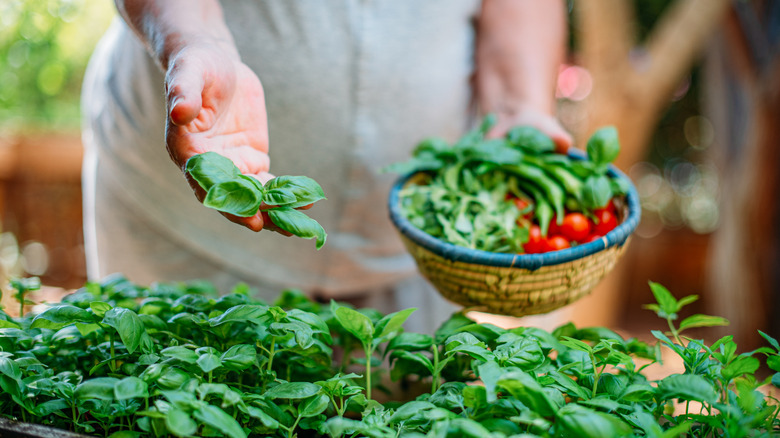How To Harvest Basil For More Growth
Unlike some vegetables like cabbage, carrots, and onions, which are harvested whole, basil and other herbs are special in that, you can take from them all season long while they continue to grow. However, it's important to use the right techniques when harvesting your basil. Plucking away one leaf at a time may seem like the smart way to approach this herb, but doing so can cause the basil to become tall and thin. Lengthy, weak basil plants won't produce as many leaves and will eventually topple over and die. What's the trick to harvesting basil without stunting its growth? Keep up with regular pruning, snip the main stem above leaf nodes, and always take from the upper leaves, allowing the lower leaves to keep growing.
Frequent harvesting is actually an important part of knowing how to grow and take care of basil plants. Harvesting correctly won't just allow you to keep your plant alive for longer; it'll actually encourage your basil to grow fuller, bushier, and healthier overall. And who doesn't love gathering a fistful of fresh basil every week? Learn more about how and when to harvest basil and other key techniques to help this fragrant herb thrive all summer long.
Harvest the upper leaves often
It might seem counterintuitive, but regular pruning and harvesting will actually lead to more fresh basil in the garden. That's because the plant will focus on restoring leaves and stems instead of producing flowers or seeds, leading to bushier, fuller basil plants all season long. When plants have reached at least 6 inches tall and developed several sets of leaves, you can begin harvesting. In addition to harvesting leaves, pinch off any flowers you see to keep the plant's energy focused on growing.
Don't pick individual leaves! It's actually better for your basil plant if you snip away a section from the main stem. Harvest and prune your plant at the same time by snipping the stem about ¼ inch above a set of leaf nodes. This will allow new stems to grow in from the nodes and produce their own leaves, making the plant bushier and bringing you more basil over time! Even if you aren't consuming the fresh basil straight away, it's still good to prune your basil plants every one to two weeks, especially if they're starting to flower. However, be sure to leave at least ⅔ of the plant intact every time you prune.
Take advantage of prime growing times
Knowing when to plant and harvest basil is just as important as knowing how. Depending on where you live, the exact timeline for when to plant basil may vary. Basil thrives in warm, wet conditions, so it is usually planted in spring and grown throughout the summer. Most importantly, the soil temperatures need to be above 50 degrees Fahrenheit for your basil to survive outside, and ideally around 70 degrees or above for it to thrive. When summer is in full swing, and temperatures reach above 80 degrees, your basil plant should start rapidly producing leaves, making this the best time to harvest. Harvest your leaves early in the morning to enjoy them to their fullest!
Basil is relatively heat-tolerant compared to other vegetables and herbs and will grow quickly in full sun or partial shade as long as it is well-hydrated. Its hardiness and fresh, cooling flavor make basil an excellent choice for gardeners to grow and enjoy during the hot summer days and even into the first warm weeks of autumn. Be sure to harvest all of your basil before the first frost of the season sets in — freezing temperatures will decimate any remaining basil plants. After pruning and harvesting your basil the right way, you might feel overwhelmed by the abundance of fresh leaves, so consider turning any excess leaves into dried basil, frozen basil cubes, or canned pesto sauce to enjoy all year long!

